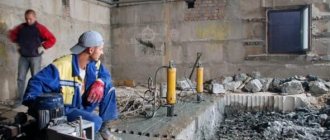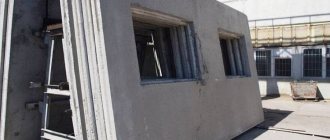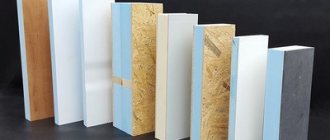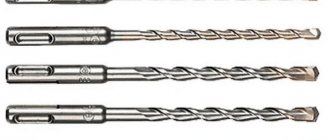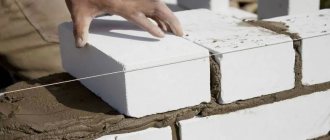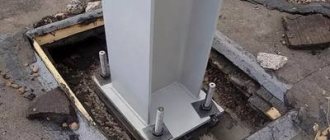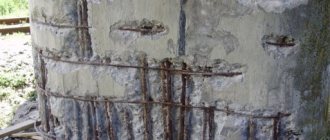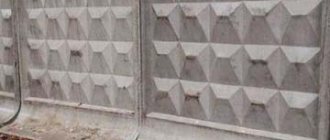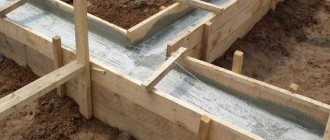The supply of electricity from power plants to consumers is carried out through power lines, the basis of which is, as a rule, reinforced concrete racks for power line supports. Without them, it would be impossible to organize the transmission of electricity over long distances. Next, we will take a closer look at what these supports are and what types they come in.
Reinforced concrete supports
General information
Initially, wooden poles served as power transmission line supports, which quickly became unusable and did not have sufficient strength. As a result, it was decided to replace them with reinforced concrete structures.
They first appeared in the Soviet Union in 1933, but became widespread in the 50s. Since then, reinforced concrete supports have gained great popularity as a result of their simple design and long service life. In addition, their undeniable advantage is their low price.
Due to the waterproofness and high frost resistance of concrete, such supports are recommended for use in any climatic conditions.
Reinforced concrete vibrating rack for power line supports
Advantages
The properties of reinforced concrete vibrating racks for electrical supports allow their use in critical environmental conditions, namely:
- resistance to corrosion changes allows the structure to maintain its original characteristics when interacting with solid, liquid, gaseous aggressive and non-aggressive environments;
- operation at temperatures up to 50 degrees Celsius;
- retain their structure and stability under seismic activity of about seven magnitude;
- withstand powerful gusts of wind.
In addition to a wide range of use and excellent quality characteristics, the designs have a number of other advantages:
- reasonable cost;
- high degree of unification and typification;
- powerful production base of products;
- long service life.
Types of racks and scope
Today the following types of reinforced concrete supports are produced:
| Prestressed vibration struts (SV). | Used for overhead power lines with voltages of 0.38-10 and 35 kW. In their manufacture, prestressed concrete is used, which ensures high strength of the concrete structure. |
| Conical struts (SC) | Manufactured according to GOST 22687-85. These supports are used in the construction of transformer groups, floodlight matches, lightning rods, etc. In addition, such racks are used on electric railways as the basis of a communication line. |
| Centrifuged stands | Used for high-voltage power lines. The production of these supports is regulated by GOST 19330-99. Based on their design, centrifuged racks come in two types:
|
| Reinforced concrete racks START | Like all previous supports, they are used in the construction of overhead power lines. They are also used as lighting stands. |
| Single post supports | This type of support is especially common. They are used as supports for power lines of 110-500 kW. |
Intermediate support
Classification by purpose
According to their purpose, racks are divided into the following types:
- Intermediate – designed to hold the weight of cables and wires. Such structures are not designed for horizontal loads. Used on straight sections of power lines.
- Anchor - used to compensate for differences in wire tension. Installed on straight sections of power lines.
- Angular – designed to compensate for the tension of wires when turning routes. Used at turning points of power lines. For turns of up to 30° degrees, intermediate corner posts are used; for angles greater than 30°, anchor-corner supports are used.
- End - designed to compensate for one-sided tension of cables and wires at the end of lines.
- Transposition - used to change the location of cables and wires on supports.
- Branch lines – designed for organizing power transmission line branches.
- Cross - used at the intersection of two power lines.
End post
Design and production of SV supports
SV posts are essentially reinforced concrete pillars.
Their structure contains embedded parts for fastening metal structures, connecting grounding elements or for installing lighting equipment. The cross-sectional shape may vary. It directly depends on the nature of the loads and operating conditions of the products. SV racks are made of concrete and reinforced with prestressed and non-stressed reinforcement. Concrete, when poured into metal forms, is subjected to vibration, which removes entrained air bubbles and thereby compacts the material. As a result, with less cement consumption, the strength, water resistance and durability of the racks increase. There is also an acceleration of the production process, which, in combination with previous factors, has a positive effect on the cost of products.
Features of reinforced concrete supports
All power transmission line supports are made from environmentally friendly high quality materials that comply with certain GOST standards. In addition, they must undergo strict multi-level quality control.
Thanks to the use of special anti-corrosion concrete, the products have an excellent service life. It should also be noted that engineers are constantly improving the designs of racks, and also using new metal alloys for their manufacture. As a result, the strength and reliability of the supports is constantly increasing.
Depending on the application of the racks, the materials from which they are made may vary. For example, if the product is intended for an area where there is severe frost in winter, then a special natural component is added to the concrete composition, which prevents it from cracking from exposure to low temperatures. To install power lines in areas with increased seismic activity, supports with increased wall thickness are used.
Lighting poles
Note! The cost of racks depends not only on the materials used for their manufacture, but also on the configuration. For example, a reinforced concrete rack SV 110 - 5 with brackets and other fasteners will have an increased cost.
If the supports need to take a large load, in cases where the distance between the supports is about 300 meters, spatial supports are used. Their elements are produced by centrifugation.
In the photo - centrifuged racks
Advantages
Due to the properties of the supports, they can be used even in adverse environmental conditions, including:
- In solid, liquid and gaseous non-aggressive and aggressive environments. This property is due to the fact that the products have good corrosion resistance.
- At average temperatures up to -55 degrees Celsius inclusive.
- With seismicity up to 7 points.
- In areas subject to strong gusts of wind.
In general, we can say that the scope of application of supports is not limited by terrain features and environmental conditions.
As for their other advantages, the following points can be highlighted:
- Relative cheapness;
- High level of typification and unification;
- The presence of a powerful production base in the country;
- Long service life, which is 40-60 years.
Flaws
Of course, along with the advantages, there are also some disadvantages:
- Reinforced concrete supports can withstand maximum loads several times less than metal ones.
- To build lines, you need to use twice as many supports.
- Require additional shipping costs.
- Loading requires the use of special equipment, since even a team of workers cannot do it with their own hands.
Scheme - reinforced concrete rack SV110 - 5
SV racks
Vibrating racks SV in the form of a trapezoidal reinforced concrete column are made of stressed and unstressed reinforced concrete that has undergone heat treatment and vibration pressing. The technology of mixing concrete mass through vibration makes it possible to increase the density and uniformity of concrete and reduce cement consumption. SV racks are most suitable for carrying out repair and reconstruction work with overhead line supports with a wide range of low voltage (from 0.4 to 35 kV).
Racks of the SV-95, SV-105 and SV-110 series are designed for power lines with voltages up to 10 kV and are often used for installation of power line supports of the intermediate and anchor corner type.
The working reinforcement elements for the SV 95-2 racks are made of two types of periodic profile steel: thermomechanically hardened and hot-rolled. Thanks to welding, such a rod has only one connection, which affects its strength. The wire reinforcement of the SV 105-5 post is prestressed and has a reverse taper in the lower part. These features allow it to be used in pits.
All modifications of SV racks can be installed in areas with extreme conditions:
- with air temperatures up to 55 degrees below zero - with a seismicity level of 9 points - with gaseous, solid and liquid aggressive and slightly aggressive environments.
Advantages of reinforced concrete SV rack
— high strength and reliability; — durability (up to 50 years); — anti-corrosion resistance; — frost resistance and moisture resistance; — seismic resistance.
SV concrete supports markings
Reinforced concrete supports SV are produced in various dimensional and design variations, so in production there are reinforced concrete products with different alphanumeric markings.
The numbers indicate the size (thickness of the product).
Marking with Roman numerals indicates the type of reinforcement (prestressed rod, non-prestressed).
Delivery of SV Racks
Delivery of the SV Rack is carried out by our own transport to Moscow, the region and other regions of Russia! Delivery estimates can be ordered in the Delivery section.
According to GOST, heavy cargo can be transported only in a horizontal position in special vehicles. When loading/unloading, it is prohibited to move several pieces at a time. Exception: rigging work with special devices, where lifting several products at the same time is allowed.
When storing in open ground, a pad with a thickness of at least 10 cm is placed at the base of the stack; a drain for water is required.
SV racks price in Moscow
SV racks price per piece. The price depends on their size, thickness, presence/absence of strengthening additives, reinforcement. In order not to overpay for the goods, it is advisable to order directly from the manufacturer at the PSK Perspektiva plant. This way you will receive certified reinforced concrete products with a laboratory report and at the best cost.
Our company can offer you the optimal balance between quality and cost.
You can request our price list and place an order in the section of the site that interests you.
Buy SV Posts at the Concrete Concrete Factory
It is profitable to buy SV Racks without intermediaries at. We are now increasing our production capacity and looking for new reliable partners.
Explanation of markings
The marking of the supports, as you might guess, carries some information about the product.
It is deciphered as follows:
- The first letters indicate the type of support;
- Numbers - indicate the length of the product in decimeters;
- The number after the hyphen indicates the calculated bending moment.
For example, reinforced concrete rack SV 95 – 3:
- Vibrating stand;
- Product length 96 decimeters;
- Design bending moment – 3 tf*m.
Accordingly, the reinforced concrete post SV 95 - 2 has the same parameters, but its design bending moment is 2 3 tf*m.
Installation of the support
Distinctive features
In Russia, vibrating stands are mainly used for electrical supports made of reinforced concrete. This material is included in the lion's share of all structures for fastening power lines.
In addition, wooden, concrete, and supports containing composite materials can be used to install power lines. As for the latter type, it is not very popular.
Concrete structures are used in construction, repair work and reconstruction of any power lines, organizing street lighting, installing fiber optics and as a device for attaching lightning rods.
The most popular today are reinforced concrete vibrating racks for electrical supports, the length of which is 9.5 and 11 meters, weight 800 and 1100 kilograms.
During the production process of the structure, the reinforcing frame is filled with concrete mortar. The manufacturing process is strictly regulated by state standards and technical specifications.
When installing lines, you must also maintain the established distance from the ground and to each other.
The support structure consists of attachments, struts, crossbars, base plates, concrete covers and metal structures. The last components include a traverse, a guy, a head, an overlay, a cable stand, fasteners, and an internal connection.
As for marking, it is applied to products in the form of an alphanumeric combination; this group is delimited using a hyphen. The first group indicates the type of stand, its length, units of measurement - decimeters. The second group informs about the load-bearing capacity of vibrated reinforced concrete racks for supports. The load-bearing capacity is characterized by the calculated bending moment, which is recorded in kN m and rounded to whole numbers.
Installation Features
Brief instructions for installing supports are as follows:
- The work begins with laying the support parts along the route for subsequent assembly.
- Then cylindrical pits are dug in the places where the racks are installed.
- Next, the assembled structures are lifted using a crane to the design position and installed in the prepared pits. In soils with low bearing capacity, installation strength is achieved by fixing the supports with crossbars and installing them on special slabs.
- Then the pit is filled with a sand and gravel mixture.
- To install guy wires, anchor plates are installed at the designed distance from the posts.
Note! When working with concrete slabs, mechanical processing may be necessary. In this case, a diamond tool is used as the most effective. For example, you may need to diamond drill holes in concrete to install anchors or cut reinforced concrete with diamond wheels.
Features of the production process
Our plant produces reinforced concrete vibrating racks for supports, using high-quality environmentally friendly materials that meet all GOST requirements. Before being processed, all components must undergo strict multi-stage control to ensure compliance with quality characteristics.
To extend the service life of our products, we use special anti-corrosion concrete.
Our company's engineers are constantly working to improve the structural characteristics of racks. We practice the use of new metals for the production of structures that help increase their strength and reliability.
The material for the manufacture of reinforced concrete vibrating racks for electrical supports differs depending on the scope of application of the structure. In places where it is possible to reduce the temperature to critical levels, structures are installed that contain a concrete mixture with the addition of special natural substances that prevent cracking.
Special treatment of the posts allows them to be buried in soil of various compositions, despite its acidity. Over a long service life, they will not collapse and will not lose their performance properties.
If the area is known for its increased seismic activity, the wall thickness is increased during the production of supports.
As for transporting vibrating racks, special vehicles are used for this. During transportation, it is necessary to stack the products with their ends in one direction. One standard machine can accommodate up to seventeen racks. To ensure optimal transport conditions, they should be securely fixed using wooden boards or pads.
Installation of products on site should only be carried out by specialists.
The assortment of the Novosibirsk Plant of Reinforced Concrete Supports and Piles can be found on the company’s website. We manufacture high quality racks that are protected from severe external loads. Our experienced managers are ready to help customers place an order and will answer any question regarding the purchase; to do this, you just need to use the feedback service.
